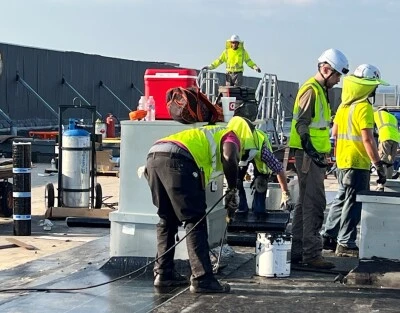
Turner Construction Company, Flatiron Construction, Liberty Mutual Insurance Company, Chubb, and The Turner Construction Company Foundation are joining forces to conduct a research project in partnership with La Isla Network to gain a deeper understanding of the effects of heat on the health of construction workers. The study reflects a collective commitment to the health and safety of people facing high heat work environments.
Hydration, rest, and shade are key to health and wellbeing in the face of high heat. As part of an active caring culture, Turner and Flatiron take steps to promote hydration and other heat mitigation measures like fans, cooling stations, shaded break areas, ready access to water stations, providing electrolytes, information about that day’s weather, along with education and awareness of the workforce on heat stress prevention and the signs of heat stress.
Turner’s Resilience Program Manager Mónika Serrano said, “This past year we conducted a pilot study that confirmed that heat affects workers’ core temperature. The study confirmed the importance of hydrating upon awakening in the morning and continuing throughout the day regardless of work activity or the temperature. As temperature and physical labor increases, water intake should increase commensurately, in combination with shade and rest.”
Continued research on this topic will inform decisions to help ensure the health and well-being of the construction workforce. This month, 200 construction workers on a large industrial construction project in the Midwest will take part in a study to measure the impact of heat. Workers on the project have easy access to shaded cooling stations. Morning huddles and signage encourage workers to hydrate before, during and after the workday.
During the study, the core temperature, heart rate and other vital signs will be monitored as workers carry out regular daily tasks. The data will help inform the effects of heat mitigation strategies in place and guide the potential development of further measures to promote health and well-being.
Sven Stranzenbach, Flatiron’s Senior Vice President of Risk Management & Sustainability said, “We are honored to participate in this study because we believe it will improve the lives of our employees and the communities where we live and work.”
Lyndsey Christofer, Executive Vice President of the Construction Industry Practice at Chubb said, “Protecting the men and women on the jobsites is a top priority at Chubb. We’re thrilled to support this study, which can provide insights and data that can be applied to improve processes and protocols on construction sites to actively keep people healthy and safe.”
“We are proud to contribute to developing research-informed, evidence-based, practical solutions that effectively reduce the risk of heat stress on worker health,” said Liberty Mutual Insurance Company Senior Vice President and General Manager of Risk Control Services, Global Risk Solutions, Dorothy Doyle. “We’re committed to understanding and improving workplace and public safety to meet our customers’ needs today and in the future.”
“We seek to create a safe and healthy work environment and take intentional actions to promote the well-being of every person who steps onto a Turner jobsite,” said Steve Spaulding, Vice President and Chief Environmental Health & Safety Officer, Turner Construction Company.
Jason Glaser, CEO of La Isla Network said, “This study will inform recommendations for continuously improving protocols that promote worker safety and well-being. By working with our incredible partners at Indiana University and University of New Mexico we are assuring the highest level of rigor and insight to this important research.” Glaser continued, “This study is also part of a global response, considering that in its latest report on safety and health at work and climate change published by the International Labor Organization has recommended that the private sector, governments and other stakeholders implement protection and risk management measures in times of climate emergency.”





